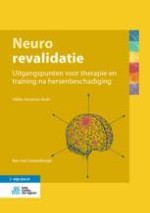Samenvatting
De fundamenten voor de neurorevalidatie zijn de afgelopen twintig jaar zeer robuust geworden: neurale plasticiteit is een realiteit: vele menselijke functies kunnen tegenwoordig door beeldvormende technieken zichtbaar worden gemaakt. Zo ook het herstel na hersenbeschadiging en de invloed van therapie en training daarop. Mechanismen achter het soms opmerkelijke herstel beginnen duidelijk te worden. Neurorevalidatie groeit uit tot een vakgebied dat veel meer inhoudt dan alleen maar motorische revalidatie. Cognitieve revalidatie en gedragsrevalidatie zijn in ontwikkeling. We realiseren ons dat de fragmentarisering in talrijke disciplines (arts, psycholoog, fysiotherapeut, logopedist enz.) niet ideaal is en zoeken naar methodes om de patiënt op een consistente manier te benaderen. De werkwijze volgens de empirische cyclus kan een verbindende schakel vormen binnen een interdisciplinair team.

